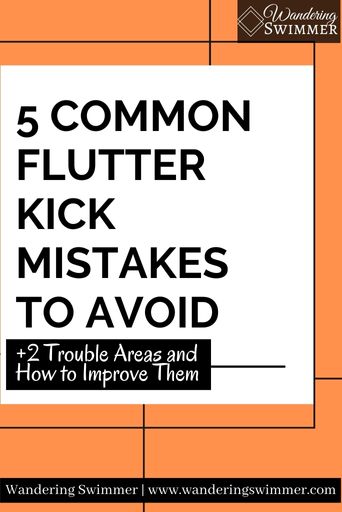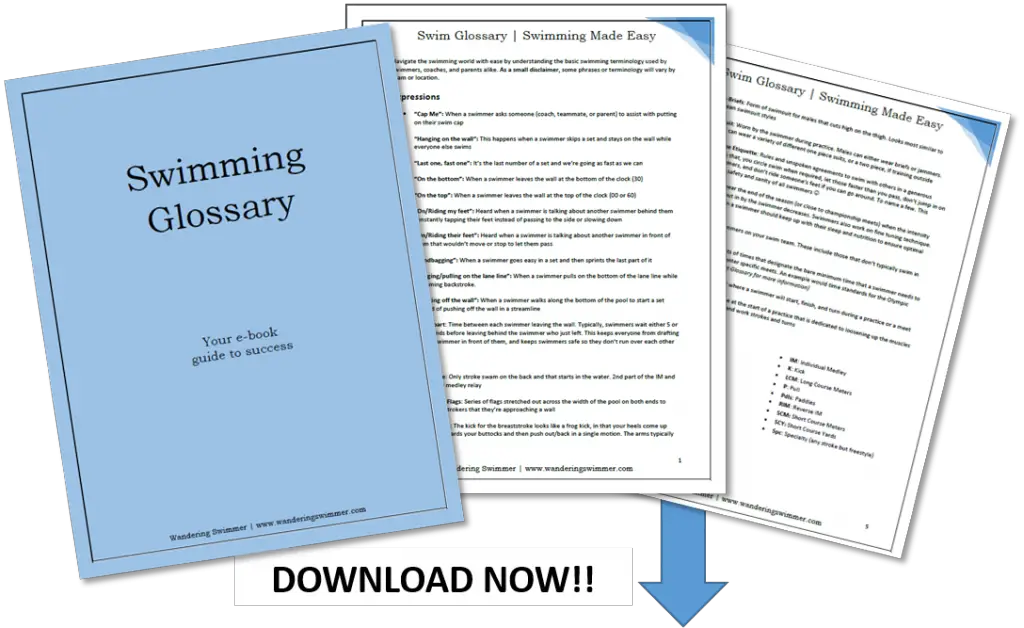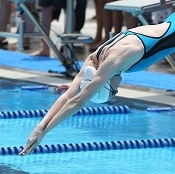Swimming is a hard workout and sport for various reasons. One thing that can make swimming so difficult is an incorrect technique. When it comes to flutter kicking, there are a few mistakes that can make swimming difficult for you.
Here are the top 5 common flutter kick mistakes people make while swimming freestyle and how to fix them. We also have two bonus issues that you may face while kicking in freestyle and how to improve them!
Please note that this article is more about flutter kick mistakes. If you’re looking for freestyle stroke mistakes, check out our sister article: 7 Freestyle Mistakes And How to Correct Them
Disclosure: This post may contain affiliate links, meaning we earn a small commission at no cost to you if you purchase something through one of our links. As an Amazon Associate, we earn from qualifying purchases. Please check out our disclosure page for more information

In a Nutshell
| Issue | Mistake Causing the Issue | Solution |
|---|---|---|
| Your hips are sinking in the water | Bending at the hips and bringing your knees up to your chest | Kick with your legs out behind you and don’t try to crunch while swimming |
| Trouble kicking/not going anywhere with your kick | Bicycle kicking from the knees | Keep your legs straight behind you and only bend them slightly when kicking |
| Bending the knees too much when kicking so your feet are coming out of the water | Don’t bend your knees so your shins leave the water. Keep them mostly straight with a slight knee bend | |
| Too deep of a kick | Shorten your kick so it’s more shallow, about a foot under the water | |
| Not kicking at all | Start kicking! 🙂 | |
| Your foot is cramping | Pointing your toes/feet too much | Let your feet relax and flex your ankles instead of forcing the feet to point |
| Ankles have trouble flexing | Inflexible ankles | Do ankle rotations to help loosen your ankles and get them more flexible |
Incorrect Flutter Kicking Technique
1. Bending at the Hips to Kick
Trying to bend at your hips to kick is a common flutter kick mistake. It’s mostly common because it so closely mirrors the kick when used to doggy paddle. Which is sometimes the first form of swimming some people learn.
However, when you try to bend your hips instead of keeping them horizontal in the water, your knees drop and typically force your legs vertically into the water. Doing this lowers your hips so you feel as though you’re sinking.
Related article: How to Flutter Kick When Swimming Freestyle
It also makes for a very start-stop motion and can impact your freestyle stroke. Usually, because you’re trying to time your stroke with each kick of the leg. And because of the delay this type of kick causes, the stroke in turn becomes delayed.
2. Bicycle Kicking
Admittedly, this is my biggest pet peeve in swimming. Kicking from the knees or ‘bicycle kicking’ is a common mistake people make while flutter kicking.
Bicycle kicking, as the name implies, is an incorrect kicking motion that looks like you’re pedaling a bike. A bike that’s horizontal and in the water 🙂
When you bicycle kick, you drag your knees down and through the water, which creates resistance. Doing so may also make you bend at the hips, which has the unfortunate side effect of your hips sinking.
The severity of the bicycle kicking varies by the swimmers. Some will bring their knees up just enough that it causes drag and it’s not too obvious. Others will bring them up almost to their hip so that their thighs are nearly vertical in the water.
Related article: 11 Ways to Improve Your Freestyle Kick
This is an inefficient way to kick. Not only that, it’s an exhausting way to kick, takes far more effort, and you won’t go anywhere.
Easy and fast swimming is about being streamlined and efficient in the water. Minimizing resistance (or drag) while moving forward in the water.
3. Knee Kicking
Knee kicking is also as the name applies. Bending at your knees and kicking only from the knees. This engages only the shins instead of the entire leg. You’re only creating a splash and not going very far.
And yes, kicking this way is a sure way to make your hips sink in the water because your body isn’t balanced in the water.
Another reason this is an incorrect flutter kick technique is due to the lack of utilizing your enter leg. Flutter kick uses your full leg, from the hips and thigh, down to the ankles and feet.
Related article: 8 Flutter Kick Drills to Learn How to Kick in Freestyle
If you’re only kicking from your knee and down, you’re not engaging every component of your leg. Not only does this greatly reduce the propulsion that the flutter kick provides, but you also aren’t doing anything.
Bending your knees and bringing them up to kick out of the water requires little effort. Which is why you don’t go anywhere! It’s a lot of work (and splashing) for very little gain.
4. Kicking too Deep
A deep and wide sweeping kick is a common flutter kick mistake you should avoid. It’s tempting to think that the deeper and longer the kick, the faster you’ll go. In actuality, it’s the opposite!
This is true for 3 reasons:
- Dropping your leg deep into the water creates resistance (or drag) and slows you down
- It’s slower to make wide, sweeping motions with your legs. Not just because of the drag the motion produces but also because the legs are traveling more distance than a short and narrow kick
- When your legs kick down and deep into the water, your hips will follow them
When you use a short and narrow kick, your kick stays in line with your body and reduces the amount of drag. And keeping your kick tight means your legs can kick faster. These together can help keep your hips higher in the water so you can swim easier.
More Content for You: How Many Laps in a Pool is a Mile?
We recommend a flutter kick that’s not deeper than about a foot to a foot and a half. Anything else will be too deep and cause you to struggle with your flutter kick.
5. Not Kicking
This should sound like common sense but you’d be surprised how many people avoid kicking. Both lap and competitive swimmers! But not kicking is a common flutter kick mistake you should avoid. Especially if you’re wanting to get better at swimming.
When you avoid kick sets during your workout or just don’t kick at all while you’re swimming, you’re not doing anything to improve your freestyle stroke. Doing this also develops a greater dislike of kicking.
We’re not saying you need to spend your full workout kicking. But, you should try to put in a small kick set into every (or at least every other) workout. As you develop and grow your kick, you may find that you like it more than you realized!
More Content for You: How Many Calories Does Swimming Burn?
Correct Way to Kick in Freestyle
The correct kick in freestyle is with your legs always behind you and only the slightest bend to the knees. Your knees will bend slightly when you’re bringing your leg up on the upward cycle of your kick.
Flex your ankles and kick from your thighs. Don’t try to force your feet to point. Instead, let your ankles flex with the motion of your kick and they’ll point naturally. Lastly, your kick shouldn’t be going any deeper than a foot to a foot and a half.
Related article: Why is Swimming so Hard?
It’s best to practice kicking while stationary first so you can get the feel of kicking correctly. Try the following steps:
- Hold onto the gutter or edge of the pool and float on your stomach
- With your legs out behind you, begin kicking with a focus on kicking from your thighs.
- While kicking, duck your head briefly under the water to watch your kick. You’ll be able to tell if your legs are straight behind you or if they’re bending too much
- If you’re bringing them up to your chest, you’ll feel your hips dipping towards the wall
- Remember to keep your kicks short and narrow. You don’t need large, deep kicks
Practice this whenever you’re in the water to get the feeling of kicking correctly. It will take time and can help if you have a workout buddy who can watch your kick to provide feedback.
If your pool has deep water, try kicking vertically while in the deep end. You’ll be able to see your knees coming up to your chest or bending behind you if you’re just knee-kicking. Again, kick from your thighs and flex your ankles:)
BONUS 1: Over Pointing Your Toes
While it looks like your toes point in the flutter kick, this action occurs more because the ankle is flexing. Not that the swimmer is forcefully pointing their feet.
If you are trying to point your toes while you flutter kick, you may find that your foot and/or calves will start to cramp. This is especially true if you’re wearing fins, as the added weight puts more pressure on them.
A cramp here or there isn’t a big deal. But when it’s consistent, it becomes a problem that you need to find the root of. Typically, it’ll come from over-pointing your toes but there could be other reasons, such as diet or not drinking enough water.
Related article: The 10 Best Swim Fins for Swimmers
Fixing Foot Cramps While Kicking
Relax your feet and stop trying to force your toes to point.
Instead, allow your ankles to flex during the kick. The motion of the legs through the water will cause your ankles to flex and naturally move your feet into a more pointed position.
You should also try to improve the flexibility of your ankles while out of the water. Flexible ankles can help with foot cramps while kicking and can make swimming just a bit easier 🙂
BONUS 2: Inflexible Ankles
Part of helping improve your flutter kick and preventing foot cramps while kicking is to have flexible ankles. While inflexible ankles aren’t a mistake in the flutter kick (or swimming), it is something that you should try to improve.
Flexible ankles make it easier to kick, for all strokes, and can also make it more comfortable when executing a flip turn.
More Content for You: A Swimmer’s Review of Adoretex Swim Parka
Improving Ankle Flexibility
The nice thing about improving ankle flexibility is that it doesn’t require much to do. Just some time and commitment!
We’re of the opinion that ankle rotations are the best way to improve your ankle flexibility for swimming. This happens when you draw a circle in the air with your foot in both clockwise and counterclockwise motions.
You can also flex your ankle up and down or side to side to help work the flexibility.
Do this at least once or twice a day and you should see some improvement in your ankle flexibility.
In Closing
While there aren’t make flutter kick mistakes to avoid or correct, the few that are there are still important. Every bit of the kick in freestyle ties together and improving one thing can make a vast difference for your swimming!
As always, happy swimming!
Chevron
Bonus Content
The 11 Best Kickboards for Swimming: Kickboards come in all shapes, sizes, and materials. Finding the best kickboard for you might seem easy enough but which is the right one for you?
How to Fix Common Swim Goggle Problems: Swim goggles. You love them but hate the problems that can come with them. Before you ditch your goggles for good, try some of these fixes.

Want to Improve at the Pool?
Join swimmers and swim parents to receive my free newsletter and receive a free Swimming Glossary e-book as a thanks!
Every month you’ll receive tips and coaching to help you find success at the pool.
About

Chevron is a current competitive swimmer with almost 20 years of experience in the pool. And although she fell into the sport by accident in her high school years, she still trains daily and competes throughout the year. She’s committed to providing guidance to all levels of swimmers and believes that everyone should know how to swim.